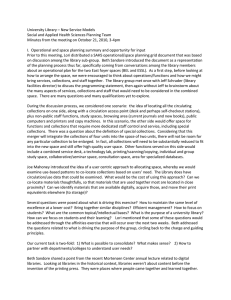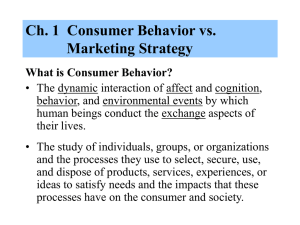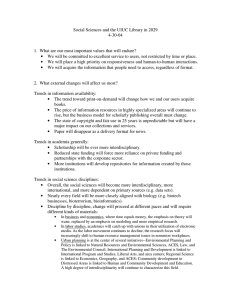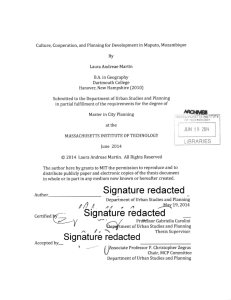Social and Applied Health Sciences Planning Team Meeting
advertisement
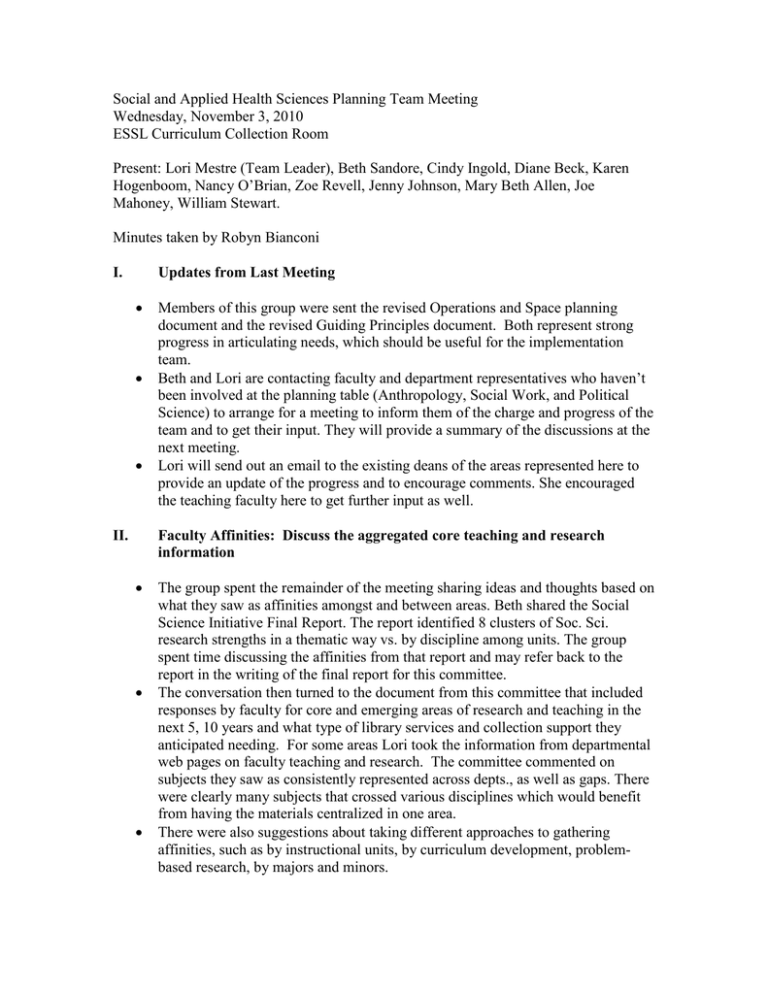
Social and Applied Health Sciences Planning Team Meeting Wednesday, November 3, 2010 ESSL Curriculum Collection Room Present: Lori Mestre (Team Leader), Beth Sandore, Cindy Ingold, Diane Beck, Karen Hogenboom, Nancy O’Brian, Zoe Revell, Jenny Johnson, Mary Beth Allen, Joe Mahoney, William Stewart. Minutes taken by Robyn Bianconi I. Updates from Last Meeting • • • II. Members of this group were sent the revised Operations and Space planning document and the revised Guiding Principles document. Both represent strong progress in articulating needs, which should be useful for the implementation team. Beth and Lori are contacting faculty and department representatives who haven’t been involved at the planning table (Anthropology, Social Work, and Political Science) to arrange for a meeting to inform them of the charge and progress of the team and to get their input. They will provide a summary of the discussions at the next meeting. Lori will send out an email to the existing deans of the areas represented here to provide an update of the progress and to encourage comments. She encouraged the teaching faculty here to get further input as well. Faculty Affinities: Discuss the aggregated core teaching and research information • • • The group spent the remainder of the meeting sharing ideas and thoughts based on what they saw as affinities amongst and between areas. Beth shared the Social Science Initiative Final Report. The report identified 8 clusters of Soc. Sci. research strengths in a thematic way vs. by discipline among units. The group spent time discussing the affinities from that report and may refer back to the report in the writing of the final report for this committee. The conversation then turned to the document from this committee that included responses by faculty for core and emerging areas of research and teaching in the next 5, 10 years and what type of library services and collection support they anticipated needing. For some areas Lori took the information from departmental web pages on faculty teaching and research. The committee commented on subjects they saw as consistently represented across depts., as well as gaps. There were clearly many subjects that crossed various disciplines which would benefit from having the materials centralized in one area. There were also suggestions about taking different approaches to gathering affinities, such as by instructional units, by curriculum development, problembased research, by majors and minors. • • • • There was some concern about identifying emerging areas because those could be trends/failures. How can the library have a better gauge on areas where the campus wants to move, but also where core support need to be? This could mean continuing support, or changing to a new areas. This is not a resolved question for Collection Development. There is not a simple divide between traditional core and “new core”. Must keep balance between the strengths of the collection and the research and teaching needs of students. The group also discussed possibilities of not including Business or Economics, for example, as part of the area, given that there seems to be strong affinities with other areas, such as Engineering and Agriculture. It was agreed that we should put forward more than one scenario in the final report. Suggestions: Conduct focus groups for feedback on user needs and expectations and to see if it would make sense to combine disciplines. Also get info. from students and faculty on what services they want to find in a library. Pursue affinities in terms of scenarios or ways to configure these units? This is like the discipline issue – it’s hard to think of two distinct library spaces with different types of service as a unit. Would rather think in terms of two units pulling together several areas into a logical arrangement. Would be better off serving the users by having people on hand to answer questions in those two spaces. Is this one mega-unit, or two distinct service points w/parallel services? III. Benefits that might derive from the library’s transition from the three existing physical libraries to a single, combined set of services and interfiled collections? • House all the print journals together. That is something that was proposed in the Operational Space planning document (at least for the disciplines that will go into that space). • Many reasons to have a combined circulating and reference collection. This would combine books on similar subjects in the same location. Students only need to go to one location rather than 3 or more and get help for all those disciplines in one place. • Even if it is decided to put Business/Economic books elsewhere, such as a fundamental intro to business/economics book collection for undergrads in the undergraduate library, patrons will still need the expertise of how to use databases, build statistical reports, bringing expertise together and where to find information so having a home place that provides the research support is important. • Develop a web presence to bring the online resources together in these areas • So much benefit to collaboration, team-teaching, for interrelated areas or to support various classes that include content from various disciplines o Space planning with GA, staff and resource spaces: provides the ability to combine resources and pool people who are doing the same functions. Also provides a benefit of GA assistance to those who currently don’t have that support. • With more staff working together, can keep/extend hours the library is open and many students want longer/later hours. For applied health and geography this is a definite benefit for access. IV. What should not be lost from individual libraries? • • • • • • • • • Although interdisciplinary benefits are great, there are also unique things we want to protect. Not to build silos, but to have students understand what’s in the library. Want to maintain program distinctions, so students are able to access and make sense of the library. Organizing by discipline is fairly efficient, so student know what is in a library How to not lose sense of disciplinarity? This plan works if everything is in one place, but nothing is, and increasingly nothing will be. We gravitate toward consolidation. What is important? Is it finding the materials in a discipline that supports research? What is in that structure that’s important? It would be great to have library for every dept, but we can’t do that. It’s not just finding the materials, but finding an individual within the library, with whom they can have a discourse, who is an expert in that discipline. In a unit that pulls in many disciplines, the librarians will need to communicate as many types of specialists. It’s important to have someone (librarian) outside of the teaching dept who understands the language/needs of the dept. Goes beyond just the materials. Need to find a balance between size and continued relationship building so students/faculty identify with staff/librarians. Need to find ways to help students understand that this is their library. Don’t want to lose the value of having students in one place with the same research interests (congregate together). Students make a community in the library; they support each other through their studies. Want to assure that the relationship and trust building between specialists, materials and patrons continues. o This often includes “hand-holding” done with students and faculty to encourage library use. Need to be better about giving a face to the libraries, which becomes even more important if there’s no physical space. Feature virtual reference at top level of the page, you see who is available in real time, with their picture (if agreeable by the librarian). o The librarians become the brand-name. Most successful schools have the faculty as brand names. Those are the people you need to highlight. These things enhance the relationships. Don’t want to lose the concept of the library as third place, library is special. o Name and physical design of the library contributes to that—must be welcoming (furniture, spaces, configurations, design…) o Look to other libraries that are considered welcoming, comfortable, well designed for a variety of student spaces, services, functions V. Wrap-up • Next meeting, Nov 17th. o Need to see if we can lengthen the meeting, and there is another one after Thanksgiving (Dec 1st) o In the next few weeks we will be speaking with those departments not represented at this planning table and will also distribute a message to update depts. who are here. Will hopefully have draft outline of the preliminary report for next meeting.
